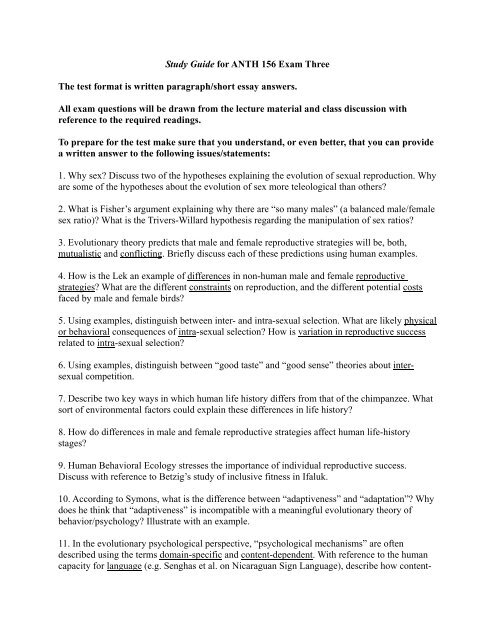Study Guide for ANTH 156 Exam Three The test format is written ...
Study Guide for ANTH 156 Exam Three The test format is written ...
Study Guide for ANTH 156 Exam Three The test format is written ...
Create successful ePaper yourself
Turn your PDF publications into a flip-book with our unique Google optimized e-Paper software.
<strong>Study</strong> <strong>Guide</strong> <strong>for</strong> <strong>ANTH</strong> <strong>156</strong> <strong>Exam</strong> <strong>Three</strong><br />
<strong>The</strong> <strong>test</strong> <strong>for</strong>mat <strong>is</strong> <strong>written</strong> paragraph/short essay answers.<br />
All exam questions will be drawn from the lecture material and class d<strong>is</strong>cussion with<br />
reference to the required readings.<br />
To prepare <strong>for</strong> the <strong>test</strong> make sure that you understand, or even better, that you can provide<br />
a <strong>written</strong> answer to the following <strong>is</strong>sues/statements:<br />
1. Why sex? D<strong>is</strong>cuss two of the hypotheses explaining the evolution of sexual reproduction. Why<br />
are some of the hypotheses about the evolution of sex more teleological than others?<br />
2. What <strong>is</strong> F<strong>is</strong>her’s argument explaining why there are “so many males” (a balanced male/female<br />
sex ratio)? What <strong>is</strong> the Trivers-Willard hypothes<strong>is</strong> regarding the manipulation of sex ratios?<br />
3. Evolutionary theory predicts that male and female reproductive strategies will be, both,<br />
mutual<strong>is</strong>tic and conflicting. Briefly d<strong>is</strong>cuss each of these predictions using human examples.<br />
4. How <strong>is</strong> the Lek an example of differences in non-human male and female reproductive<br />
strategies? What are the different constraints on reproduction, and the different potential costs<br />
faced by male and female birds?<br />
5. Using examples, d<strong>is</strong>tingu<strong>is</strong>h between inter- and intra-sexual selection. What are likely physical<br />
or behavioral consequences of intra-sexual selection? How <strong>is</strong> variation in reproductive success<br />
related to intra-sexual selection?<br />
6. Using examples, d<strong>is</strong>tingu<strong>is</strong>h between “good taste” and “good sense” theories about intersexual<br />
competition.<br />
7. Describe two key ways in which human life h<strong>is</strong>tory differs from that of the chimpanzee. What<br />
sort of environmental factors could explain these differences in life h<strong>is</strong>tory?<br />
8. How do differences in male and female reproductive strategies affect human life-h<strong>is</strong>tory<br />
stages?<br />
9. Human Behavioral Ecology stresses the importance of individual reproductive success.<br />
D<strong>is</strong>cuss with reference to Betzig’s study of inclusive fitness in Ifaluk.<br />
10. According to Symons, what <strong>is</strong> the difference between “adaptiveness” and “adaptation”? Why<br />
does he think that “adaptiveness” <strong>is</strong> incompatible with a meaningful evolutionary theory of<br />
behavior/psychology? Illustrate with an example.<br />
11. In the evolutionary psychological perspective, “psychological mechan<strong>is</strong>ms” are often<br />
described using the terms domain-specific and content-dependent. With reference to the human<br />
capacity <strong>for</strong> language (e.g. Senghas et al. on Nicaraguan Sign Language), describe how content-
dependent domain-specific mental mechan<strong>is</strong>ms will differ in function from content-independent<br />
and domain-general mechan<strong>is</strong>ms (e.g. tabula rasa models of the brain).<br />
12. People seem more able to correctly complete Wason’s selection task when it <strong>is</strong> presented in<br />
social contexts with conditional social rules. D<strong>is</strong>cuss the evolutionary rationale <strong>for</strong> these<br />
outcomes as argued by Cosmides and Tooby (in Cartwright). What <strong>is</strong> the rationale <strong>for</strong> Sugiyama<br />
and colleagues repeating th<strong>is</strong> <strong>test</strong> in a non-Western <strong>for</strong>aging society?<br />
13. How does “Hume’s Guillotine”, that “ought” must be d<strong>is</strong>tingu<strong>is</strong>hed <strong>for</strong>m “<strong>is</strong>” in accounts of<br />
human affairs, impact controversies over hot-button <strong>is</strong>sues in evolutionary theory. D<strong>is</strong>cuss in<br />
relation to a human propensity <strong>for</strong> violence and self<strong>is</strong>hness; or biological and behavioral sexdifferences.<br />
14. Appeals to Nature to resolve moral <strong>is</strong>sues in human affairs (“good” versus “bad”) invoke the<br />
Natural<strong>is</strong>tic fallacy. Using examples (e.g. such as whether or not violence, sex differences, or<br />
herbal supplements are “natural”), d<strong>is</strong>cuss how the natural<strong>is</strong>tic fallacy confuses what <strong>is</strong> “good”<br />
and “bad” in reference to Nature, evolution, and human affairs.<br />
15. <strong>The</strong> Environment of Evolutionary Adaptation (EEA) <strong>is</strong> a key concept <strong>for</strong> Evolutionary<br />
Psychological theory. What <strong>is</strong> a definition of the EEA, why <strong>is</strong> it important to Evolutionary<br />
Psychology, and what are some of the points of contention about what we can know about it?<br />
16. Data about the life-ways and subs<strong>is</strong>tence strategies of living human <strong>for</strong>agers are interpreted<br />
in different ways by evolutionary theor<strong>is</strong>ts. Briefly d<strong>is</strong>cuss some key differences in the<br />
interpretation of these data by Human Behavioral Ecolog<strong>is</strong>ts and Evolutionary Psycholog<strong>is</strong>ts.
















